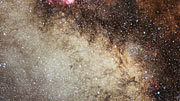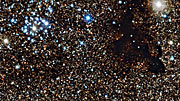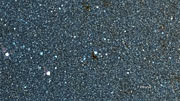Persbericht
‘Een druppel inkt op de heldere hemel’
Wide Field Imager maakt kiekje van kosmische gekko
13 februari 2013
Deze opname, gemaakt met de Wide Field Imager van de 2,2-meter MPG/ESO-telescoop van de ESO-sterrenwacht op La Silla in Chili, toont de heldere sterrenhoop NGC 6520 en de naastgelegen donkere wolk Barnard 86 die de vorm heeft van een gekko. Dit kosmische duo steekt duidelijk af tegen de gloed van het helderste deel van de Melkweg – een gebied dat zo dicht met sterren is bezaaid, dat er bijna geen donker stukje hemel meer te zien is.
Dit deel van het sterrenbeeld Boogschutter (Sagittarius) is een van de rijkste sterrenvelden aan de hemel: de Grote Sagittarius Sterrenwolk. De vele sterren die dit gebied doen oplichten contrasteren sterk met het zwart van donkere wolken als Barnard 86, die een centrale positie inneemt op deze opname van de Wide Field Imager, een instrument dat aan de 2,2-meter MPG/ESO-telescoop van de ESO-sterrenwacht op La Silla is gekoppeld.
Dit object – een kleine, op zichzelf staande donkere nevel die men een Bok-globule noemt [1] – is door zijn ontdekker, de veelzijdige Amerikaanse astronoom Edward Emerson Barnard [2], omschreven als ‘een druppel inkt op de heldere hemel’. Barnard, een buitengewoon goede waarnemer en ijverige astrofotograaf, was de eerste die donkere nevels bestudeerde aan de hand van lang belichte opnamen.
Door een kleine telescoop lijkt Barnard 86 op een sterrenarm gebied of een venster op een ver stukje maagdelijke hemel. Maar in werkelijkheid staat dit object juist op de voorgrond van de sterrenwolk. Het betreft een koude, dichte, donkere wolk, bestaande uit kleine stofdeeltjes die het licht van verder weg gelegen sterren tegenhouden. Vermoedelijk gaat het om het restant van de moleculaire wolk die de naburige sterrenhoop NGC 6520 (op deze foto links van Barnard) heeft voortgebracht.
NGC 6520 is een open sterrenhoop die veel hete, blauwwitte sterren bevat – een duidelijke aanwijzing dat deze sterren jong zijn. Open sterrenhopen bevatten doorgaans een paar duizend sterren die ruwweg tegelijkertijd zijn ontstaan en dus allemaal even oud zijn. Doordat hun sterren geleidelijk uit elkaar drijven, bestaan zulke sterrenhopen maar relatief kort: enkele honderden miljoenen jaren.
Doordat de ongelooflijke aantallen sterren in dit hemelgebied de waarnemingen bemoeilijken, is er over deze sterrenhoop verder niet zoveel bekend. Geschat wordt dat NGC 6520 ongeveer 150 miljoen jaar oud is. Zowel de sterrenhoop als zijn stoffige buurman zijn ruwweg 6000 lichtjaar van ons verwijderd.
De sterren die zich op deze foto in Barnard 86 lijken te bevinden, staan in werkelijkheid op de voorgrond, dus tussen de donkere wolk en ons in. Hoewel het onduidelijk is of dit ook in Barnard 86 nog het geval is, worden in het hart van veel donkere wolken – zoals de beroemde Paardenkopnevel (eso0202), het markante object Lupus 3 (eso1303) en in mindere mate ook in de eveneens door Barnard ontdekte Pijpnevel (eso1233) – nog steeds nieuwe sterren gevormd. Het licht van de jongste sterren wordt echter tegengehouden door het omringende stof, waardoor zij alleen zichtbaar zijn in het infrarood of licht van nog langere golflengten.
Noten
[1] Bok-globules werden in de jaren veertig van de vorige eeuw ontdekt door de Nederlands-Amerikaanse astronoom Bart Bok. Het zijn zeer koude, donkere wolken van gas en stof waarbinnen vaak nieuwe sterren worden gevormd. Globules zijn rijk aan stof dat het licht van achtergrondsterren verstrooit en absorbeert, waardoor zij op visuele golflengten vrijwel ondoorzichtig zijn.
[2] Dit citaat komt uit het artikel ‘Dark Regions in the Sky Suggesting an Obscuration of Light’, dat op 15 november 1913 in Astrophysical Journal is verschenen (online-versie).
Meer informatie
ESO is de belangrijkste intergouvernementele astronomische organisatie in Europa en de meest productieve sterrenwacht ter wereld. Zij wordt ondersteund door vijftien landen: België, Brazilië, Denemarken, Duitsland, Finland, Frankrijk, Italië, Nederland, Oostenrijk, Portugal, Spanje, Tsjechië, het Verenigd Koninkrijk, Zweden en Zwitserland. ESO voert een ambitieus programma uit, gericht op het ontwerpen, bouwen en beheren van grote sterrenwachten die astronomen in staat stellen om belangrijke wetenschappelijke ontdekkingen te doen. Ook speelt ESO een leidende rol bij het bevorderen en organiseren van samenwerking op astronomisch gebied. ESO beheert drie waarnemingslocaties van wereldklasse in Chili: La Silla, Paranal en Chajnantor. Op Paranal staan ESO’s Very Large Telescope (VLT), de meest geavanceerde optische sterrenwacht ter wereld, en twee surveytelescopen: VISTA werkt in het infrarood en is de grootste surveytelescoop ter wereld en de VLT Survey Telescope is de grootste telescoop die uitsluitend is ontworpen om de hemel in zichtbaar licht in kaart te brengen. ESO is ook de Europese partner van de revolutionaire telescoop ALMA, het grootste astronomische project van dit moment. Daarnaast bereidt ESO momenteel de bouw voor van de 39-meter Europese Extremely Large optical/near-infrared Telescope (E-ELT), die ‘het grootste oog op de hemel’ ter wereld zal worden.
Links
- Foto’s van de 2,2-meter MPG/ESO-telescoop
- Andere opnamen die met de 2,2-meter MPG/ESO-telescoop zijn gemaakt
- Foto’s van La Silla
Contact
Richard Hook
ESO, La Silla, Paranal, E-ELT and Survey Telescopes Public Information Officer
Garching bei München, Germany
Tel: +49 89 3200 6655
Mob: +49 151 1537 3591
E-mail: rhook@eso.org
Rodrigo Alvarez (press contact België)
ESO Science Outreach Network
en Planetarium, Royal Observatory of Belgium
Tel: +32-2-474 70 50
E-mail: eson-belgië@eso.org
Over dit bericht
| Persberichten nr.: | eso1307nl-be |
| Naam: | Barnard 86, NGC 6520 |
| Type: | Milky Way : Star : Grouping : Cluster : Open Milky Way : Nebula : Appearance : Dark : Bok Globule |
| Facility: | MPG/ESO 2.2-metre telescope |
| Instruments: | WFI |
Our use of Cookies
We use cookies that are essential for accessing our websites and using our services. We also use cookies to analyse, measure and improve our websites’ performance, to enable content sharing via social media and to display media content hosted on third-party platforms.
ESO Cookies Policy
The European Organisation for Astronomical Research in the Southern Hemisphere (ESO) is the pre-eminent intergovernmental science and technology organisation in astronomy. It carries out an ambitious programme focused on the design, construction and operation of powerful ground-based observing facilities for astronomy.
This Cookies Policy is intended to provide clarity by outlining the cookies used on the ESO public websites, their functions, the options you have for controlling them, and the ways you can contact us for additional details.
What are cookies?
Cookies are small pieces of data stored on your device by websites you visit. They serve various purposes, such as remembering login credentials and preferences and enhance your browsing experience.
Categories of cookies we use
Essential cookies (always active): These cookies are strictly necessary for the proper functioning of our website. Without these cookies, the website cannot operate correctly, and certain services, such as logging in or accessing secure areas, may not be available; because they are essential for the website’s operation, they cannot be disabled.
Functional Cookies: These cookies enhance your browsing experience by enabling additional features and personalization, such as remembering your preferences and settings. While not strictly necessary for the website to function, they improve usability and convenience; these cookies are only placed if you provide your consent.
Analytics cookies: These cookies collect information about how visitors interact with our website, such as which pages are visited most often and how users navigate the site. This data helps us improve website performance, optimize content, and enhance the user experience; these cookies are only placed if you provide your consent. We use the following analytics cookies.
Matomo Cookies:
This website uses Matomo (formerly Piwik), an open source software which enables the statistical analysis of website visits. Matomo uses cookies (text files) which are saved on your computer and which allow us to analyze how you use our website. The website user information generated by the cookies will only be saved on the servers of our IT Department. We use this information to analyze www.eso.org visits and to prepare reports on website activities. These data will not be disclosed to third parties.
On behalf of ESO, Matomo will use this information for the purpose of evaluating your use of the website, compiling reports on website activity and providing other services relating to website activity and internet usage.
Matomo cookies settings:
Additional Third-party cookies on ESO websites: some of our pages display content from external providers, e.g. YouTube.
Such third-party services are outside of ESO control and may, at any time, change their terms of service, use of cookies, etc.
YouTube: Some videos on the ESO website are embedded from ESO’s official YouTube channel. We have enabled YouTube’s privacy-enhanced mode, meaning that no cookies are set unless the user actively clicks on the video to play it. Additionally, in this mode, YouTube does not store any personally identifiable cookie data for embedded video playbacks. For more details, please refer to YouTube’s embedding videos information page.
Cookies can also be classified based on the following elements.
Regarding the domain, there are:
- First-party cookies, set by the website you are currently visiting. They are stored by the same domain that you are browsing and are used to enhance your experience on that site;
- Third-party cookies, set by a domain other than the one you are currently visiting.
As for their duration, cookies can be:
- Browser-session cookies, which are deleted when the user closes the browser;
- Stored cookies, which stay on the user's device for a predetermined period of time.
How to manage cookies
Cookie settings: You can modify your cookie choices for the ESO webpages at any time by clicking on the link Cookie settings at the bottom of any page.
In your browser: If you wish to delete cookies or instruct your browser to delete or block cookies by default, please visit the help pages of your browser:
Please be aware that if you delete or decline cookies, certain functionalities of our website may be not be available and your browsing experience may be affected.
You can set most browsers to prevent any cookies being placed on your device, but you may then have to manually adjust some preferences every time you visit a site/page. And some services and functionalities may not work properly at all (e.g. profile logging-in, shop check out).
Updates to the ESO Cookies Policy
The ESO Cookies Policy may be subject to future updates, which will be made available on this page.
Additional information
For any queries related to cookies, please contact: pdprATesoDOTorg.
As ESO public webpages are managed by our Department of Communication, your questions will be dealt with the support of the said Department.







